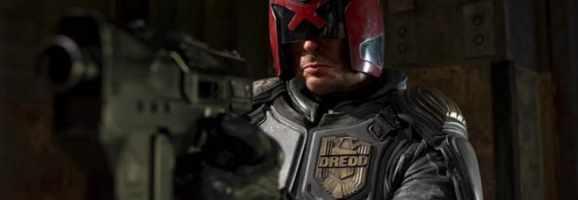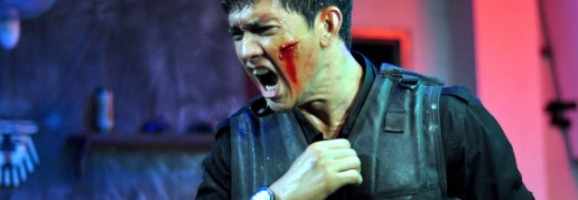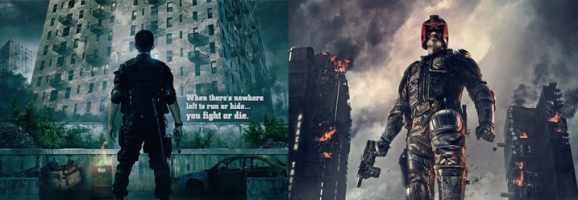Dredd, The Raid, and the Power of Formula
“Everything’s the same!”
Such is the rallying cry for those that disparage modern media. There exists a certain group of people who think that, in the past, there was a rampant creative period of almost nothing but original ideas and that most media released in the past twenty years has been merely riding its coattails. Perhaps their most common complaint is how far too many movies today are dependent on formulaic storytelling, leading to an age where almost all creative works are similar enough to be interchangeable. In 2011 and 2012, these detractors gained even more ammunition for their assault on modern media with the release of two films, The Raid: Redemption and Dredd, both of which had an eerily similar plot and certainly used the same formula.
However, much to many people’s surprise, both movies received both critical acclaim and cult classic status, seemingly in spite of their similar formulaic backbones. Critics praised their focused and brutally efficient execution and they are now considered modern classics of the action film genre. In the case of these two movies, the use of formula did not work against them. In fact, one might even say that their adherence to a particular formula led to its biggest strengths. Even if the detractors of formula are right about modern media being more formulaic now than in the past (which they aren’t), the still make the mistake of seeing formula as an inherently bad thing. In the face of common opinion, the quality of these two films shows how the use of formula in storytelling can be a good thing instead of the end of all creativity as its detractors would like to think. Both The Raid: Redemption and Dredd show that there is a place in modern cinema for formula.
Exhibit A: Dredd

In the many years following the disastrous Sylvester Stallone-led first cinematic outing of the famous 2000 A.D. character Judge Dredd, many fans still wished for the ruthless yet fair law enforcer to make it back to the silver screen without the PG-13 flair that plagued the previous entry. Luckily, around 2006, writer and producer Alex Garland put forth an effort to give the honorable Judge his next outing in theaters for the first time in the new millennium. Garlan, aided by director Pete Travis, decided to take a different approach than the earlier, sprawling blockbuster style of the Stallone version because of the limits imposed by the relatively small budget of $50 million. Because of those imposed limits, the filmmakers decided to create a story set in a single location along with a straightforward plot, reminiscent of other action movies.
Dredd follows the story of the eponymous Judge Dredd (Karl Urban)–a one-man SWAT team in the future dystopia of Mega-City One. During a routine investigation, he is trapped in a 200-story high-rise building controlled by ruthless drug kingpin Ma-Ma (Game of Thrones‘ Lena Headey) along with his new rookie partner, Judge Anderson (Olivia Thirlby). Throughout the movie, Dredd is faced with wave after wave of criminal foot soldiers, limited resources, and even corrupt Judges as he tries to make it to the top floor where Ma-Ma is waiting for him. Already, this sounds like a very formulaic action movie plot that requires very little setup and has been done innumerable times since the 1980s, but Dredd received critical acclaim–receiving 78% approval on Rotten Tomatoes–for its tight and focused plot and characters, which worked as a strong skeleton to build the stylish yet visceral action scenes around. Instead of spending the inordinate amount of time spent on worldbuilding required for most modern Sci-Fi movies, Dredd cuts to the chase by putting the characters–and the viewer, in turn– right into the action. Instead of wasting time and effort on building a structure of its own, it takes advantage of a familiar one in order to build a unique movie around it.
However, by the time Dredd hit theaters in 2012, it was beaten to the punch by an Indonesian martial arts film with a similar plot–The Raid: Redemption.
Exhibit B: The Raid: Redemption

The Raid was a project conceived by Welsh-born director and writer Gareth Evans, who originally wanted to make a sprawling crime epic with the added injection of martial arts action–The Godfather mixed with Fists of Fury. However, being a relatively inexperienced director, there was no way he could secure the funds necessary to have this vision become a reality. Instead, he decided to make a smaller, more focused movie that would put all of the emphasis on the action, an approach extremely similar to that of Dredd.
The Raid: Redemption tells the story of Rama (Iko Uwais, who also co-choreographed the action scenes), a member of an elite police squad in Jakarta, who is sent in with his squad to take out a powerful drug boss in control of a high-rise building. Of course, Rama and his squad are trapped inside and are forced to fight their way out and take out the drug kingpin. However, this simple setup is the vehicle for the real star of the show, the Indonesian martial art known as Pencak Silat. The abundance of the excellent action scenes that the movie is known for is allowed by the use of formula because it relies on the audience’s familiarity with its simple action setup in order to not spend as much time building it from the ground up. Because of this, The Raid: Redemption also gained critical acclaim–85% approval on Rotten Tomatoes–because of its intense and pulse-pounding action scenes that look just as bone-crunchingly visceral as they would in real life. The success of The Raid’s first outing led to Evans finally getting the financial support needed to make his original vision of an action epic a reality in the sequel, The Raid 2: Berandal, released earlier this year.
Any person with even a tiny bit of knowledge of action movie formulas can instantly see the similarities between The Raid: Redemption and Dredd, but just because they have an extremely similar plot structure, there are also a large number of differences that allow each of them to stand on their own. For example, the action in Dredd is primarily focused on stylized gun play while The Raid focused on the aforementioned Pencak Silat with a bit of gunplay thrown in to change up the pace. The Raid even takes Dredd’s cut-to-the-chase approach even further by only showing a short scene in the beginning to introduce our main lead immediately before starting the mission.
What do these two examples show?
It seems to be no surprise that some of the most notable examples of popular movies that make use of a formula are action movies. Action movies, with their often single-minded desire to show as many explosions, gun fights, and martial arts showdowns have received notoriety for relying greatly on formula; one might even say too much. A more cynical person would compare the entire action film genre to pornography, with everything from sets, characters, and plot merely being a vehicle for the action (in all senses of the word). However, many of the most acclaimed films of the genre made great use of formula. Perhaps the most famous and best use of formula is the classic 80s action film, Die Hard. The now-classic set-up of an everyman forced to deal with an enemy with legions of foot soldiers has gained a unique position as the main formula used in action movies, with movies as disparate as Speed, Air Force One, Snakes on a Plane, and even Paul Blart: Mall Cop. It has even received the dubious award of being recognized by TvTropes, now recognized as “Die Hard on an X.”
The success of Dredd and The Raid: Redemption seems to be part of the next evolution of action formula. Both movies seem to revolve around a permutation of the Die Hard formula, keeping some elements (enclosed spaces as a setting, limited resources as a plot point, etc.) while jettisoning some others (most notably the everyman protagonist). This shows that, while the presence of formula may mean that individual movies may seem to be similar, there is always room for the formula itself to improve to meet the needs of the action. Just because something uses a formula does not mean that the formula can’t change.
In conclusion, while many would be willing to criticize the use of formula in a film, they may be getting ahead of themselves by presuming that formula is a bad thing. By watching recent, successful films like Dredd and The Raid: Redemption or classic action flicks like Die Hard, one can easily say that a simple formula leaves more than enough room to make a fantastic film. While there will always be filmmakers who use storytelling formulas as a crutch (as the deluge of Hero’s Journey films has shown us), great filmmakers like Gareth Evans, Alex Garland, and Pete Travis use a formula in the same way a Jazz musician would use the notes on a page of music to make a work of great art.
What do you think? Leave a comment.












The Raid all day long. Amazing fight scenes. Wasn’t overly taken with Dredd I have to say.
The Raid would be an easy pick for me. Dredd was a ton of fun and it has mega replayability but The Raid was on another level.
I love both of them. I give the slightest edged to Dredd. Mainly because MA Ma was a more memorable villain. The action scenes in The Raid were a lot better though.
I adored the Dredd movie so much I want to marry it. For me, it completely nailed what I wanted a Dredd movie to look like and to feel like.
Two films for different audiences using the same formula. Those looking for the martial arts have Raid. Those looking for 80′s-inspired gunplay have Dredd.
The Raid definitely is revolutionary in action scenes. Although the film isn’t that good (at least to me), the action scenes make me want to watch it again and again.
“The film isn’t that good” … “the action scenes make me want to watch it again and again.” -Bit of a contradiction there.. this is a martial arts action film that does not pretend to be anything else. If you like the action, you like the film.
Wonderful post and an interesting comparison. Formula is something that has undergone a lot of criticism lately but it really can work if it’s executed well! I haven’t seen either of these films but I’m sure I’ll watch The Raid soon.
Warrior is another great example! Pulls every trope in the book with its characters and plot. But when it’s as well done as it is in these films, you really don’t mind!
Both films are crackers!
I rewatched Dredd the just recently, but in 3D this time. Not a big fan of 3D but it worked well in Dredd. Dredd itself still holds up so well, I am convinced that in five, ten years time it will be a big cult movie and people won’t believe it failed to get an audience or a sequel. I like The Raid but I LOVE Dredd.
Dredd in 3d at the movies looked an absolute treat.
I loved Dredd–a vastly better version than the PoS Stallone version.
Everyone has been telling me how good The Raid is I just need to sit down and see it.
The Raid is definitely a must-see too for all action movie fans… just non-stop brilliance.
I love the topic you chose. I definitely think the “Formula” aspect goes along with the issues revolving around original ideas. I was told once that “good writing” is “good stealing”. There aren’t necessarily original ideas but being able to take everything you can do and making it your own is what makes it “original.” Great work!
I really enjoy this article. I’d love to read more of your analysis of other films. This is a great template for a much larger work. Well done.
I think this is an interesting comparison that could go further, especially when it comes to the specific action beats, as well as genre conventions. “Dredd” is a sci-fi movie and that aspect is central to its narrative, as well as its action scenes. The Raid, meanwhile, is set in the present day/real world, which results in a more grounded aesthetic. Both film avoid the over-complicated plots typical of modern action movies, especially the big budget blockbusters.
Dredd had some fantastic cinematography, and I think that’s something else you can add onto an established formula to make a film really stand out. It’s interesting how Dredd lacks much flesh on its story, though. I think that would have also really helped it stand out.
Actually, I disagree with you. I think Dredd has plenty of flesh on its story thanks to the characters. Heck, who would have known that the stone-faced badass Judge Dredd would ever go through any character development? Judge Anderson’s character arc is pretty solid too.
in my view, both films have the same storyline , but definitely good acting thrown in ” The Raid ” because a lot of action , played . However, both the story is so amazing . The Raid say i’ve watched it many times
As much as I loved Dredd, it cannot be denied that it was a complete rip off of The Raid. Unoriginal and it should not be given any credit for originality. The creators should be ashamed… at least as much as I am ashamed for enjoying it. Artistic thieves.